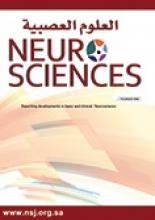Research ArticleOriginal Article
Open Access
Effects of thymoquinone, the major constituent of Nigella sativa seeds, on penicillin-induced epileptiform activity in rats
Ersin Beyazcicek, Seyit Ankarali, Ozge Beyazcicek, Handan Ankarali, Serif Demir and Recep Ozmerdivenli
Neurosciences Journal April 2016, 21 (2) 131-137; DOI: https://doi.org/10.17712/nsj.2016.2.20150781
Ersin Beyazcicek
From the Departments of Physiology (Beyazcicek E, Ankarali S, Beyazcicek O, Demir, Ozmerdivenli), and Biostatistics (Ankarali H), Medical School, Duzce University, Duzce, Turkey
MSciSeyit Ankarali
From the Departments of Physiology (Beyazcicek E, Ankarali S, Beyazcicek O, Demir, Ozmerdivenli), and Biostatistics (Ankarali H), Medical School, Duzce University, Duzce, Turkey
MDOzge Beyazcicek
From the Departments of Physiology (Beyazcicek E, Ankarali S, Beyazcicek O, Demir, Ozmerdivenli), and Biostatistics (Ankarali H), Medical School, Duzce University, Duzce, Turkey
MSciHandan Ankarali
From the Departments of Physiology (Beyazcicek E, Ankarali S, Beyazcicek O, Demir, Ozmerdivenli), and Biostatistics (Ankarali H), Medical School, Duzce University, Duzce, Turkey
PhDSerif Demir
From the Departments of Physiology (Beyazcicek E, Ankarali S, Beyazcicek O, Demir, Ozmerdivenli), and Biostatistics (Ankarali H), Medical School, Duzce University, Duzce, Turkey
PhDRecep Ozmerdivenli
From the Departments of Physiology (Beyazcicek E, Ankarali S, Beyazcicek O, Demir, Ozmerdivenli), and Biostatistics (Ankarali H), Medical School, Duzce University, Duzce, Turkey
PhD
References
- ↵
- McDaniel SS,
- Wong M
- ↵
- Ngugi AK,
- Kariuki SM,
- Bottomley C,
- Kleinschmidt I,
- Sander JW,
- Newton CR
- ↵
- Ghosheh OA,
- Houdi AA,
- Crooks PA
- ↵
- El-Dakhakhny M
- ↵
- Ashraf SS,
- Rao MV,
- Kaneez FS,
- Qadri S,
- Al-Marzouqi AH,
- Chandranath IS,
- et al.
- ↵
- Gholamnezhad Z,
- Keyhanmanesh R,
- Boskabady MH
- ↵
- Orient A,
- Donkó A,
- Szabó A,
- Leto TL,
- Geiszt M
- ↵
- Elmowalid G,
- Amar AM,
- Ahmad AA
- ↵
- Bakathir HA,
- Abbas NA
- ↵
- Koka PS,
- Mondal D,
- Schultz M,
- Abdel-Mageed AB,
- Agrawal KC
- ↵
- Qadri S,
- Mahmud H,
- Föller M,
- Lang F
- ↵
- Asgary S,
- Sahebkar A,
- Goli-malekabad N
- ↵
- Radad K,
- Hassanein K,
- Al-Shraim M,
- Moldzio R,
- Rausch WD
- ↵
- Ahlatci A,
- Kuzhan A,
- Taysi S,
- Demirtas OC,
- Alkis HE,
- Tarakcioglu M,
- et al.
- ↵
- Alhebshi AH,
- Gotoh M,
- Suzuki I
- ↵
- Akhondian J,
- Kianifar H,
- Raoofziaee M,
- Moayedpour A,
- Toosi MB,
- Khajedaluee M
- ↵
- Hosseinzadeh H,
- Parvardeh S,
- Nassiri-Asl M,
- Mansouri MT
- ↵
- Khazdair MR
- ↵
- Hosseinzadeh H,
- Parvardeh S
- ↵
- Raza M,
- Alghasham AA,
- Alorainy MS,
- El-Hadiyah TM
- ↵
- Bahadir A,
- Demir S,
- Orallar H,
- Beyazcicek E,
- Oner F
- ↵
- Cakil D,
- Yildirim M,
- Ayyildiz M,
- Agar E
- ↵
- Yildirim M,
- Marangoz AH,
- Ayyildiz M,
- Ankarali S,
- Marangoz C
- ↵
- Albertson AJ,
- Williams SB,
- Hablitz JJ
- ↵
- Parsons CG,
- Stöffler A,
- Danysz W
- ↵
- Dichter MA,
- Ayala GF
- ↵
- Gilhotra N,
- Dhingra D
- ↵
- Abdel-Zaher AO,
- Mostafa MG,
- Farghly HM,
- Hamdy MM,
- Omran GA,
- Al-Shaibani NK
- ↵
- Ullah I,
- Ullah N,
- Naseer MI,
- Lee HY,
- Kim MO
- ↵
- Lemos JR,
- Ortiz-Miranda SI,
- Cuadra AE,
- Velázquez-Marrero C,
- Custer EE,
- Dad T,
- et al.
- ↵
- Gebhardt C,
- Breustedt JM,
- Nöldner M,
- Chatterjee SS,
- Heinemann U
- ↵
- Kovács Z1 CzurkóA,
- Kékesi KA,
- Juhász G
- ↵
- Carletti F,
- Ferraro G,
- Rizzo V,
- Cannizzaro C,
- Sardo P
In this issue
Effects of thymoquinone, the major constituent of Nigella sativa seeds, on penicillin-induced epileptiform activity in rats
Ersin Beyazcicek, Seyit Ankarali, Ozge Beyazcicek, Handan Ankarali, Serif Demir, Recep Ozmerdivenli
Neurosciences Journal Apr 2016, 21 (2) 131-137; DOI: 10.17712/nsj.2016.2.20150781
Effects of thymoquinone, the major constituent of Nigella sativa seeds, on penicillin-induced epileptiform activity in rats
Ersin Beyazcicek, Seyit Ankarali, Ozge Beyazcicek, Handan Ankarali, Serif Demir, Recep Ozmerdivenli
Neurosciences Journal Apr 2016, 21 (2) 131-137; DOI: 10.17712/nsj.2016.2.20150781
Jump to section
Related Articles
- No related articles found.
Cited By...
- No citing articles found.





